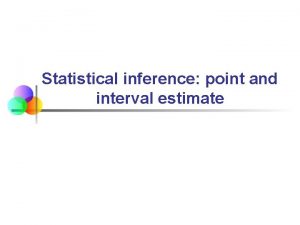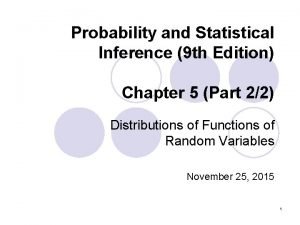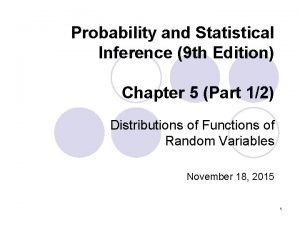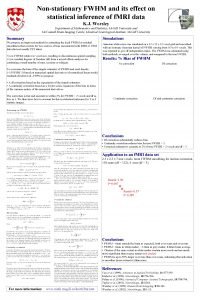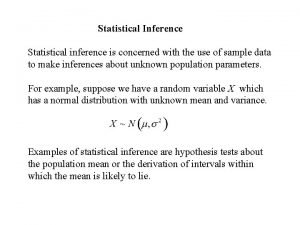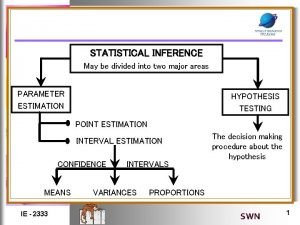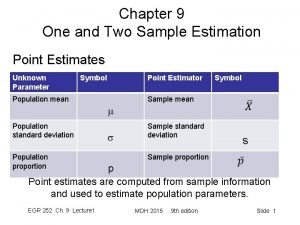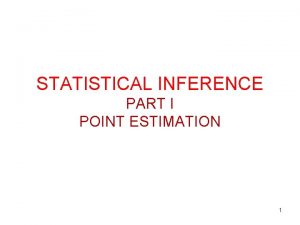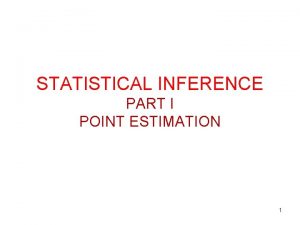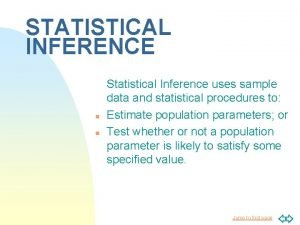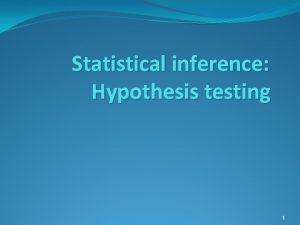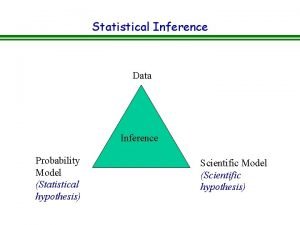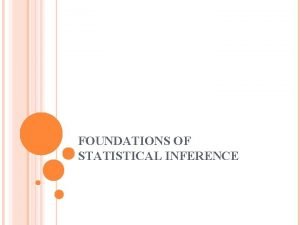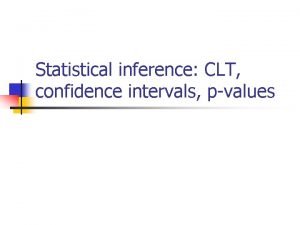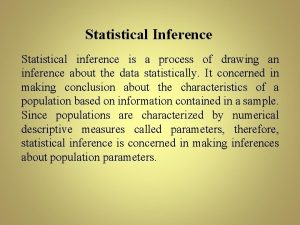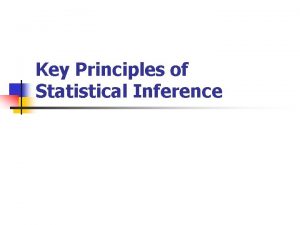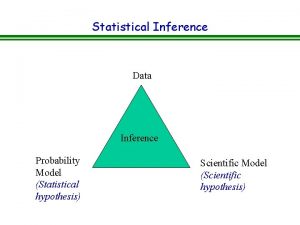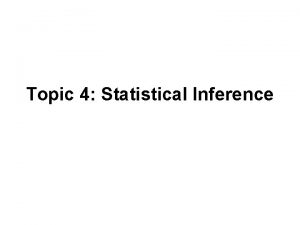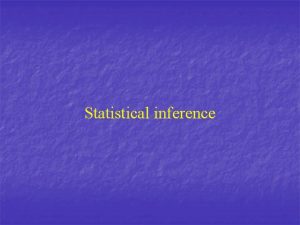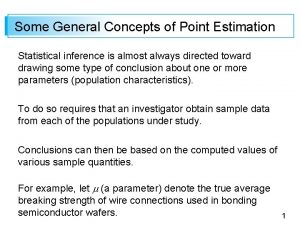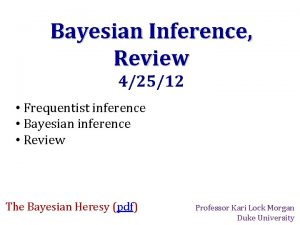Estimation Point Estimation Statistical Inference for Managers Lecture























- Slides: 23

Estimation (Point Estimation) Statistical Inference for Managers Lecture- 5 By Imran Khan

Estimation We are given information of a sample and using this information, we estimate any quantity of population. Point Estimation: The objective of point estimation is to obtain a single number from the sample which will represent the unknown value of the population parameter. Estimator: An estimator is a sample statistic used to estimate a population parameter.

Properties of a good Estimator • Unbiasedness • Efficiency • Consistency

Unbiasedness: The point estimator θ^ is said to be an unbiased estimator of θ if the expected value or mean of the sampling distribution of θ^ is θ. Example: The sample mean and sample variance are unbiased estimators of their population parameters.

Bias The Bias in an estimator θ^ is defined as the difference between its mean and θ Bias (θ^)= E(θ^)- θ

Properties of a good Estimator Efficiency: Is another property of a good estimate which refers to the size of standard error of statistics. So the most efficient estimator will be the one having smaller standard error. An estimator with a smaller standard error will produce an estimate closer to the population parameter.

Properties of a good Estimator Consistency: A statistic is consistent estimator of population parameter if the value of the statistic comes very close to the population parameter as the sample size increases. Consistency is a large sample property.

Properties of a good Estimator The sample mean x is the best estimator of μ as it is un-biased, consistent and the most efficient estimator. Point Estimate of the population variance: E(s²)= σ²- Proof required! Var(x) = σ²/n

Estimation Interval estimation: An Interval estimate describes a range of values within which a population parameter is likely to lie. We represent confidence interval by the quantity (1 - α). P= sample proportion π= population proportion

Estimation Case-1: Interval for population mean when population standard deviation is known:

Example Upon collecting a sample of 250 from a population with known standard deviation of 13. 7, the mean is found to be 112. 4. a) Find a 95% confidence interval for the mean. b) Find a 99% confidence interval for the mean.

Case-2: Interval for Population mean when population standard deviation is unknown and n>30:

Case-3: Interval for population mean when population standard deviation is unknown and n<30 Using t-distribution

Example: A business school placement officer wants to estimate the mean annual salaries of the school’s former students 5 years after graduation. A random sample of 25 such graduates found a sample mean of $42, 740 and a sample standard deviation of $4, 780. Assuming that the population distribution is normal, find a 90% confidence interval for the population mean. T-Table= 1. 711

Case- 4: Interval for difference of two population means when population standard deviations σ1 & σ2 are known: Example: The following data is given: X 1 bar= 4000 X 2 bar= 3500 σ1= 500 n 1= 16 σ2= 300 n 2= 9 Find a 95% interval for the difference of two population means?

Case-5: Interval for difference of two population means when σ1 & σ2 are unknown and n 1>30, n 2>30.

Case-6: Interval for difference of two population means when σ1 & σ2 are unknown and n 1<30, n 2<30.

Case-7: Interval for population proportion when σ is unknown

Case-8: Interval for difference of two population proportions

Example-1: In a random sample of 120 large retailers, 85 used regression as a method of forecasting. In an independent random sample of 163 small retailers, 78 used regression as a method of forecasting. Find a 99% confidence interval for the difference between the two population proportions?

Example-2: Pair 1 2 3 4 5 6 7 8 Drug-A 29 32 31 32 32 29 31 30 Drug-B 26 27 28 27 30 26 33 36 Using the above data, estimate with a 99% confidence the mean difference in the effectiveness of the two drugs A & B, to lower cholesterol.

Table values for Interval Estimation: 90% Confidence Interval- z= 1. 64 95% Confidence Interval- z= 1. 96 99% Confidence Interval- z= 2. 58

 Point estimation
Point estimation Proof of chebyshev's inequality
Proof of chebyshev's inequality Probability and statistical inference 9th solution pdf
Probability and statistical inference 9th solution pdf Statistical inference
Statistical inference Statistical inference is concerned with
Statistical inference is concerned with Statistical inference is divided into
Statistical inference is divided into 01:640:244 lecture notes - lecture 15: plat, idah, farad
01:640:244 lecture notes - lecture 15: plat, idah, farad Customs in things fall apart
Customs in things fall apart Population proportion symbol
Population proportion symbol Fspos
Fspos Typiska novell drag
Typiska novell drag Nationell inriktning för artificiell intelligens
Nationell inriktning för artificiell intelligens Vad står k.r.å.k.a.n för
Vad står k.r.å.k.a.n för Shingelfrisyren
Shingelfrisyren En lathund för arbete med kontinuitetshantering
En lathund för arbete med kontinuitetshantering Adressändring ideell förening
Adressändring ideell förening Personlig tidbok
Personlig tidbok Sura för anatom
Sura för anatom Vad är densitet
Vad är densitet Datorkunskap för nybörjare
Datorkunskap för nybörjare Tack för att ni lyssnade bild
Tack för att ni lyssnade bild Att skriva debattartikel
Att skriva debattartikel Delegerande ledarstil
Delegerande ledarstil Nyckelkompetenser för livslångt lärande
Nyckelkompetenser för livslångt lärande
